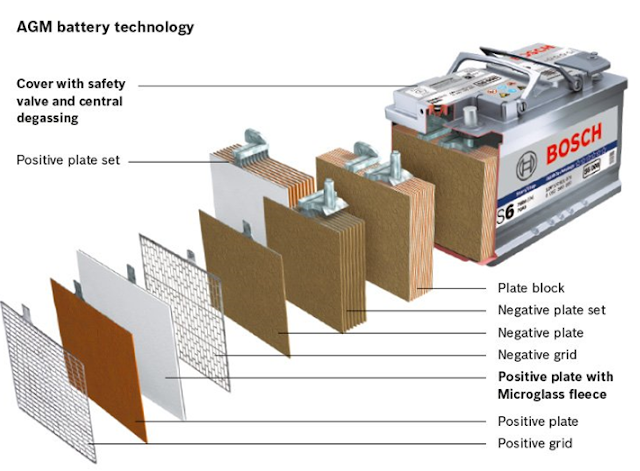Structure and operating principle of Acid Batteries
Acid battery | lead acid battery has a lot of important applications, it is the starting source of DC motors, a reserve power source that ensures continuous power supply for a certain period of time ... So to know Acid batteries | how lead acid battery can charge / discharge, we first need to know its structure and operation principle.
Structure of Acid battery / lead acid battery
Both types, alkaline and acid batteries, they are similar in structure, we will mainly learn about acid batteries.
General structure of acid - Lead battery acid battery
Acid batteries include tank covers, inside with separate compartments. Compartment number depends on the average rated voltage:
- 6V battery usually 3 compartments (2.1V / 1Cell).
- 6-pin 12V common battery (2.1V / 1Cell).
Cylinders:
- Manufacturing from all kinds of ebonite, axphantopec.
- To increase the durability and acid resistance, it is forced into an acid resistant lining of 0.6 mm thick with poluclovinlim, to increase the life of the shell.
- Inside the shell divided into separate partitions, at the bottom of each compartment, there are 4 supporting supports for the pole block, forming a gap - avoiding the phenomenon of shattering caused by "sulfate lead" when discharging electricity.
- Battery compartments are connected together by a bridge to the battery.
2 Electrodes (+ Anode, - Cathode) from the Head Cell and the End Cell of the battery.
Electrolyte solution: H2SO4 + H2O.
Detailed construction of acid battery / lead acid battery
Electrode grid plate: Create the necessary strength for the electrode, on the other hand it focuses the current, reducing the resistance for the electrode.
Each cell contains several electrodes of negative and positive plates, from pure lead and lead oxide with high porosity and durability.
The pole block and alternately insulated together through a high porosity partition. Extremely similar plates (+, -) are soldered to the pole lugs according to the specified number and form the pole block.
Structure of the cell of lead battery battery
Basically, Cell includes: Electrodes (anode + cathode) and electrolyte
Negative pole: Anode (pole made of lead - lead - Pb).
Anode: Cathode (Pole plate made of lead-oxide oxide-PbO2).
Usually the positive plates, the battery's sound is not equal.
The insulation plate between two electrodes must have a large permeability. A plane facing the cathode charge, the other side has a wave shape or a direction toward the anode.
Distilled water + H2SO4 is prepared according to the prescribed concentration depending on the climatic conditions and the material for the partition. The concentration of batteries can range from 1.21g / cm3 to 1.31g / cm3.
Especially not to:
High concentration + hot climate.
Low concentration + temperate.
Principle of operation of lead acid batteries
Lead acid batteries - Discharge of electricity
At negative pole: Pb
Pb in electrolyte solution: Pb2 + + 2e- (negative pile has a lot of electrons)
At anode: PbO2
PbO2 + H20 -> Pb4 + + 4OH- (positively charged)
Electronic excess cathode, anode is missing electron. If connecting wires through 2 poles via 1 light bulb, electricity will be generated, light bulbs will glow.
Then: Discharge battery, lead sulfate is formed in two electrodes + create water -> concentration of solution + electrolyte battery decreases.
Charge the battery
There is gas escaping from the two electrodes.
Principle of charging of acid batteries
The anode connected to the power source has PbO2, the remaining pole has Pb, and also causes water shortages due to H2 and O2 exhaust. This is the reason to add dilute H2SO4 solution.
Read more:
Structure and operating principle of Acid Batteries
 Reviewed by BiT
on
4:50 AM
Rating:
Reviewed by BiT
on
4:50 AM
Rating:
 Reviewed by BiT
on
4:50 AM
Rating:
Reviewed by BiT
on
4:50 AM
Rating:













No comments: